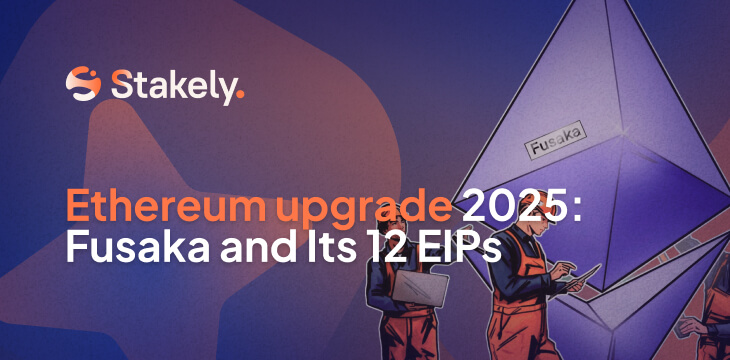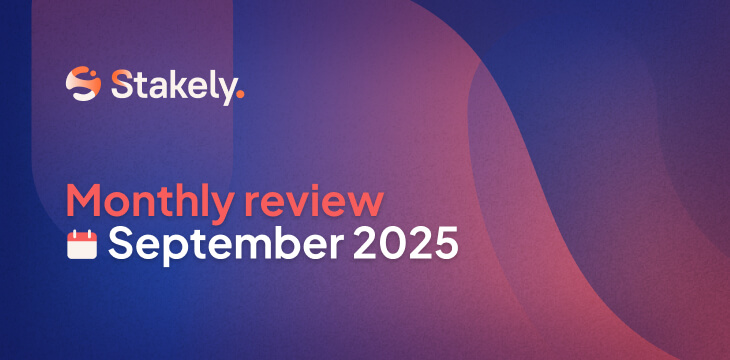All about Ethereum’s upcoming Fusaka upgrade and its 12 EIPs

Ethereum continues to move forward on its roadmap toward a more scalable, secure, and decentralized network. The next major milestone is Fusaka, an infrastructural-level upgrade scheduled for late 2025, most likely in November. Its goal is to improve data availability, optimize costs for Layer 2 solutions, and lay the groundwork for future innovations like Verkle Trees and stateless clients.
In this article, we explain everything you need to know about Fusaka, why it represents a key step in Ethereum’s evolution, and what impact it could have on users, developers, and validators.
The road to Fusaka: previous upgrades
Before diving into the details, let’s briefly review the upgrades that have brought us here, following the “Lean Ethereum” plan:
- Merge (2022): transition to Proof-of-Stake.
- Shapella (2023): enabled ETH withdrawals from staking.
- Dencun (2024): introduced proto-danksharding and blobs to reduce L2 fees.
- Pectra (2025): increased the stake limit per validator and improved UX and blob capacity.
Each of these milestones has brought Ethereum closer to its goal of achieving 10,000 TPS without sacrificing decentralization or security. See its real-time roadmap.
What is Fusaka and why is it important?
Fusaka is short for Fulu-Osaka. This upgrade focuses on increasing Ethereum’s capacity to handle large volumes of data without compromising decentralization — a crucial need for the rollup and L2 ecosystem, which now handles the majority of the network’s transactions.
Its standout feature is PeerDAS (Peer-to-Peer Data Availability Sampling), which allows nodes to verify rollup data through sampling, without downloading the full block. This reduces bandwidth, storage, and CPU usage, while laying the foundation for full Danksharding.
It also proposes to quadruple the Layer 1 gas limit, increasing throughput and optimizing L2 batch publication. Additionally, Fusaka does not alter the EVM or break contracts, ensuring compatibility and stability for users and developers, while preparing the ground for enhancements like Verkle Trees and stateless clients.
Impact of the Fusaka upgrade on the ecosystem
- Users: Lower fees on L2 and smoother access to dApps, DeFi, and NFTs.
- Developers: Better rollup performance, lighter verification, and more efficient contracts.
- Validators: Lower data load, reduced storage requirements, and better protection from on-chain spam.
- Investors: Strengthens Ethereum’s role as the base layer of Web3, although price will still depend on external factors.
The 12 EIPs of the Fusaka upgrade explained
The Fusaka upgrade includes 12 Ethereum Improvement Proposals (EIPs) ranging from data availability enhancements to cryptographic optimizations. Here’s a breakdown of each:
1. EIP-7594: PeerDAS (Peer data availability sampling)
Enables nodes to verify rollup data availability via distributed sampling instead of full block downloads.
Impact:
- Dramatically reduces bandwidth and storage use.
- Enables scaling blobs up to 128 per block.
- Essential base for full Danksharding implementation.
2. EIP-7642: History expiry and simpler receipts
Deletes historical data prior to May 2025, reducing node sync load.
Impact:
- Saves up to 530 GB per node.
- Faster and lighter sync, especially helpful for new validators.
3. EIP-7823: Set upper bounds for MODEXP
Sets a maximum input size of 8192 bits (1024 bytes) for the MODEXP cryptographic precompile.
Impact:
- Prevents consensus errors from arbitrary input sizes.
- Improves gas cost predictability.
- Supports real-world use cases like RSA verification without extra costs.
4. EIP-7825: Transaction gas limit cap
Introduces a 30 million gas limit per transaction to prevent one from consuming most of a block.
Impact:
- Prevents a single actor from “eating up” an entire block.
- Ensures fairer access to the network.
- Improves resilience against intentional congestion.
5. EIP-7883: ModExp gas cost increase
Raises the gas cost of the ModExp precompile to better reflect actual computation usage.
Impact:
- Minimum cost increases from 200 to 500 gas.
- Reduces incentives to abuse this precompile.
- Increases security against cheap-computation DoS attacks.
6. EIP-7892: Blob parameter only (‘BPO’) hardforks
Allows blob storage parameters to be adjusted without waiting for major upgrades.
Impact:
- Much faster response to L2 demand.
- Improves Ethereum’s adaptability without relying on big hardforks.
7. EIP-7917: Deterministic proposer lookahead
Allows future epochs to be precomputed, making block proposer schedules predictable in advance.
Impact:
- Reduces uncertainty in block assignments.
- Enables preconfirmation protocols (key for L2 UX).
- Enhances MEV mitigation tools.
8. EIP-7918: Blob base fee bounded by execution cost
Sets a minimum blob fee and ties it to execution cost to avoid fee distortions.
Impact:
- More stable L2 fees.
- Prevents unfair arbitrage between blobs and traditional execution.
9. EIP-7934: RLP Execution block size limit
Sets a 10MB limit for RLP-encoded blocks to improve node propagation and prevent DoS attacks.
10. EIP-7935: Set default gas limit to XX0M
Proposes increasing the default gas limit from 36M to a higher value, yet to be defined.
Impact:
- Enables more complex contracts and heavier workloads on L1.
- Needs balance to avoid overwhelming the network or harming decentralization.
11. EIP-7939: Count leading zeros (CLZ) opcode
Adds a new EVM instruction to count leading zeros in 256-bit values, optimizing bit manipulation and compression.
Impact:
- Reduces complexity and gas costs in Solidity.
- Drastically cuts gas in bitwise operations.
- Optimizes on-chain math algorithms.
- Improves ZK-proof applications.
- Shrinks bytecode size.
- Enables efficient compression and decompression.
- Builds a base for advanced cryptographic schemes.
12. EIP-7951: Precompile for secp256r1 Curve Support
Adds native EVM support for the P-256 (secp256r1) curve, widely used in devices and security standards.
Impact:
- Allows signature verification from mobile and hardware wallets without extra conversions.
- Compatible with existing standards like TLS.
- Makes integration with off-chain infrastructures easier.
Expected timeline for Fusaka implementation
Although the Ethereum Foundation has proposed a window from November 5–12, coinciding with Devconnect Buenos Aires, a delay of up to four weeks is possible to ensure quality and compatibility.
- September to October: testing on public testnets (Sepolia and Holesky).
- November: mainnet activation.
What comes after Fusaka?
Ethereum upgrades won’t stop! After Fusaka, Ethereum is expected to prepare for:
- Glamsterdam (2026), focusing on UX improvements, state optimization, and possibly reducing block time.
- Verge and Purge (2026–2027): Verkle Trees for light verification and EIP-4444 to prune historical data, reducing node burden.
- Surge: full implementation of Danksharding, enabling extreme scalability up to 100,000 TPS through decentralized data sampling.
Fusaka isn’t just a technical upgrade — it’s a decisive step in Ethereum’s race to lead the blockchain ecosystem in efficiency, scalability, and decentralization. By optimizing data availability and paving the way for innovations like Verkle Trees, it reinforces Ethereum’s role as the global settlement layer for Web3.
Join our Telegram channel to stay updated on Fusaka’s progress and what’s coming next. At Stakely, we’re excited to see it happen — are you?





